大学英语教师面试 说课 Unit 5 Our Weather and Climate (薛红春)
Unit 5 It will be sunny and cool tomorrow.(说课稿)-20
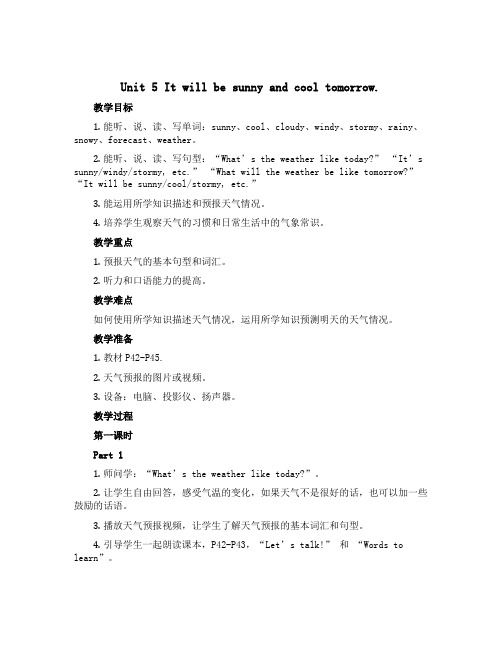
Unit 5 It will be sunny and cool tomorrow.教学目标1.能听、说、读、写单词:sunny、cool、cloudy、windy、stormy、rainy、snowy、forecast、weather。
2.能听、说、读、写句型:“What’s the weather like today?” “It’s sunny/windy/stormy, etc.” “What will the weather be like tomorrow?” “It will be sunny/cool/stormy, etc.”3.能运用所学知识描述和预报天气情况。
4.培养学生观察天气的习惯和日常生活中的气象常识。
教学重点1.预报天气的基本句型和词汇。
2.听力和口语能力的提高。
教学难点如何使用所学知识描述天气情况,运用所学知识预测明天的天气情况。
教学准备1.教材P42-P45.2.天气预报的图片或视频。
3.设备:电脑、投影仪、扬声器。
教学过程第一课时Part 11.师问学:“What’s the weather like today?”。
2.让学生自由回答,感受气温的变化,如果天气不是很好的话,也可以加一些鼓励的话语。
3.播放天气预报视频,让学生了解天气预报的基本词汇和句型。
4.引导学生一起朗读课本,P42-P43,“Let’s talk!” 和“Words to learn”。
Part 21.引导学生注意天空的变化,例如:云的形状、颜色、云的运动等。
2.问学生:“Do you know what these different clouds mean?”。
3.将课本上页的云朵图片分发给学生,让学生分组进行讨论,从而了解云朵的不同形态。
Part 31.师问学:“What will the weather be like tomorrow?”。
2.引导学生使用所学知识,描述、预测明天的天气情况。
新编实用英语综合教程1Unit5Ourweatherandclimate

Unit Five Our W eather and ClimateSection I& II Listening and SpeakingTalking Face to FaceI W arm-up Questions1. Do you often listen to a weather forecast? Why or why not?2. What’s the use and importance of a weather forecast?II Class Activities1.The students read the Mini-Talks after the teacher, and then try to recitethem within five minutes in pairs.2.Students discuss in groups, summarizing the words, phrases andsentences frequently used according to the following topics with the help of the teacher. The students speak out the sentences under the guidance of the teacher, paying attention to the pronunciation and the intonation.1)Sentences for a weatherman to present weather forecasts:(1) Good morning. This is the local weather report.(2) Here is the national forecast.(3) Now let’s look at the weather across the country.(4) Rains will be expected tomorrow from the south to the north.(5) Snow is going to continue through tomorrow in this area.(6) The weatherman says that frost is on its way.2) Sentences for talking about weather changes:(1) It’ll be mild, and later turn to partly cloudy, with the southeast wind.(2) Today will be cool and partly cloudy, with a chance of rain this afternoon.(3) Tomorrow will be overcast with drizzle.(4) In the evening there’s good chance that we’ll get some snow.(5) Today is a cloudy and cool day with a low of 12 degrees.(6) The weather will change overnight with a high temperature of zerodegrees.3) Sentences about weather for starting a conversation:(1) What’s the weather like today?(2) What is the weather report?(3) What’s the temperature?(4) What’s it like outside?(5) Will it be a nice day?(6) Lovely day, isn’t it?(7) What do you think of the weather here?3. Act-Out Activities1) Students read the sample dialogues after the teacher, trying to imitate theteacher\s pronunciation and intonation.2) Ask the students to read the sample dialogues in pairs. Then categorize theexpressions for asking questions about the weather and describing the weather conditions.4. Do Exercises 5 and 6 in pairs.Being all earsⅢ. Learning Sentences for W orkplace Communication1.Warm–up:Give the students a few minutes to read through the printed materials for each listening item in Listen and Repeat, Listen and Match. While listening, students should try to remember the meaning of each of the sentences and pay more attention to the key words.fairly 相当地mild 温和的,暖和的2. Key to Listen and Match:1-f, 2-h, 3-i 4-j, 5-g, 6-c, 7-e, 8-d, 9-a, 10-bListen and RespondKey: 1-D 2-C 3-B 4-D 5-A 6-D3. Handling a Dialogue:Script:Li Hong: Hi, Pat! Why didn’t you go to the party last night?Pat: Because it was so cold and rainy.Li Hong: That’s too bad! It was a really good party. Hey, why don’t we go out for a walk this afternoon, Pat? I need some exercise.Pat: Go out for a walk? But its so cold out.Li Hong: Cold out? Wh at’s the temperature?Pat: About 13℃.Li Hong: 13℃? That’s not cold. Just wait until winter.Pat: Why?Li Hong: Well …it snows a lot and sometimes it’s very cold. Last winter it was 7 degree below zero for three weeks. And it was windy, too.Pat: That sounds awful!Li Hong: It wasn’t all that bad. The sun was out almost every day.4. Understanding a short Speech / TalkKey: 1. tourist cities 2. beautiful3. too cold in winter4. plenty of sunshine5. the sea6. thousands of7. from both home and abroad8. at the best time of yearUnit Five Our W eather and ClimateSection III Trying your handI. Sample Analysis1. The teacher summarize briefly the format and language used in weatherforecasts.2. A weather report or forecast is a very useful aid in our daily life. Knowingthe usual format for giving a weather forecast helps us a lot in understanding a weather forecast in English. Figures, measurement units, graphics, weather terms, and broken short passages are often used to forecast weather conditions. In general, the language used to forecast weather should be concise, clear, familiar and vivid.II. Simulated Writing1. The students read and translate the two sample weather forecasts intoChinese.Useful words and expressions for describing weather:1) to rain all day 全天有雨2) to be sunny / fine / cloudy / rainy / hot / cool天气将会是阳光充足、晴、多云、有雨、很热、凉爽3) to be going to warm up / clear up 天气要转暖/放晴4) quite a warm day with temperature around 24℃天气很暖和,气温在24度左右。
教师招聘面试小学英语Unit5 Friends说课稿

教师招聘面试小学英语Unit5 Friends说课稿Part1: the analysis of teaching materialFirst of all, I’d like to give some analysis of the teaching material. The lesson is the first period of Unit 5, Oxford Primary English, book 5A. The content is about friendship, after learning this lesson, students will know some words and expressions to talk about their friends and they can cherish friendship more in the future.Part2: the analysis of studentsStudents in Primary school have learned English for just few years, they have some basic simple English surroundings, but it is still vary difficult for them to memorize some knowledge in short time. At the same time, they are curious and active,but their attention can be scattered easily, so I will design some interesting activities to attract their attention.Part3: the analysis of teaching objectives(1)Knowledge objective: Students will be able to be familiar with the topic today, and master(2)Ability objective: By practicing, students will know how to describe their friends.(3)Emotional objective: By doing various activities, students’ interest of learning English will be fostered.Part4: the analysis of teaching key&difficult pointsKey point: the understanding and the spelling of the dialogue.Difficult point: the use of the language into daily life.Part5: the analysis of teaching methodsAs we all know, by using teaching method, students can learn better and be the real host in class, so in this class, I will mainly use Situational teaching Method and Communicative Approach to arouse their interest.Part6: the analysis of teaching proceduresStep1: Warming-upThis song is closely related to today's topic, so in this way I can lead in the lesson today. At the same time, a nice learning atmosphere will be created.Step2: presentation。
大学英语u51.1 第五单元电子教案
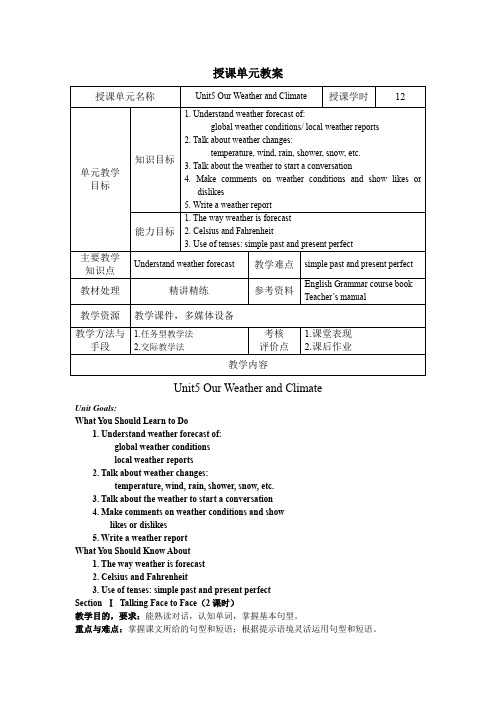
授课单元教案Unit5 Our Weather and ClimateUnit Goals:What You Should Learn to Do1. Understand weather forecast of:global weather conditionslocal weather reports2. Talk about weather changes:temperature, wind, rain, shower, snow, etc.3. Talk about the weather to start a conversation4. Make comments on weather conditions and showlikes or dislikes5. Write a weather reportWhat You Should Know About1. The way weather is forecast2. Celsius and Fahrenheit3. Use of tenses: simple past and present perfectSection ⅠTalking Face to Face(2课时)教学目的,要求:能熟读对话,认知单词,掌握基本句型。
重点与难点:掌握课文所给的句型和短语;根据提示语境灵活运用句型和短语。
教学方法与手段:在学习5个短小精练,生动有趣,针对性强,主题突出的小对话之后分别设定了一个相关的交际“任务”。
教师引导学生根据上文样例及配套的拓展教程中Data Bank 所提供相关语言材料进行口头交际模仿套用练习,取得边学边用的效果。
所需的教学仪器和设备:教学课件,多媒体设备授课主要内容:Step one: Imitating Mini-talks1.Speak and Recite: Works in pairs. Practice the following mini-talks about greeting andintroducing people.Step two: Speak and Perform2.Work in pairs and act out the tasks by following the above mini-talks.Step three: Study and ImitateStep four: Following Sample Dialogues实用英语口语:unit5,unit8学生分组进行英语口语对话练习。
高校教资英语试讲教案模板
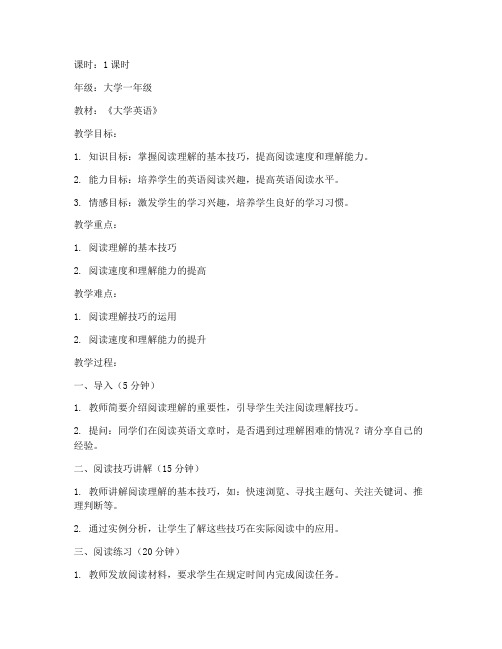
课时:1课时年级:大学一年级教材:《大学英语》教学目标:1. 知识目标:掌握阅读理解的基本技巧,提高阅读速度和理解能力。
2. 能力目标:培养学生的英语阅读兴趣,提高英语阅读水平。
3. 情感目标:激发学生的学习兴趣,培养学生良好的学习习惯。
教学重点:1. 阅读理解的基本技巧2. 阅读速度和理解能力的提高教学难点:1. 阅读理解技巧的运用2. 阅读速度和理解能力的提升教学过程:一、导入(5分钟)1. 教师简要介绍阅读理解的重要性,引导学生关注阅读理解技巧。
2. 提问:同学们在阅读英语文章时,是否遇到过理解困难的情况?请分享自己的经验。
二、阅读技巧讲解(15分钟)1. 教师讲解阅读理解的基本技巧,如:快速浏览、寻找主题句、关注关键词、推理判断等。
2. 通过实例分析,让学生了解这些技巧在实际阅读中的应用。
三、阅读练习(20分钟)1. 教师发放阅读材料,要求学生在规定时间内完成阅读任务。
2. 学生在阅读过程中,运用所学的阅读技巧,提高阅读速度和理解能力。
3. 教师巡回指导,解答学生在阅读过程中遇到的问题。
四、阅读总结(10分钟)1. 学生分享阅读过程中的收获和体会,教师进行点评。
2. 教师总结阅读理解技巧,强调在阅读过程中的重要性。
五、课堂小结(5分钟)1. 教师总结本节课的主要内容,强调阅读理解技巧在英语学习中的重要性。
2. 鼓励学生在课后继续练习阅读,提高英语阅读水平。
教学反思:本节课通过讲解阅读理解的基本技巧,引导学生关注阅读理解的重要性,并在练习环节让学生运用所学技巧,提高阅读速度和理解能力。
在教学过程中,教师应注意以下几点:1. 注重学生的主体地位,引导学生积极参与课堂活动。
2. 针对不同学生的阅读水平,进行分层教学,确保每个学生都能有所收获。
3. 加强课堂互动,鼓励学生提问、分享,提高课堂氛围。
4. 关注学生的学习效果,及时调整教学策略,确保教学目标的实现。
课后作业:1. 完成课后阅读材料,提高阅读速度和理解能力。
天津教师招聘考试英语说课稿《Unit5 B Let’s talk》
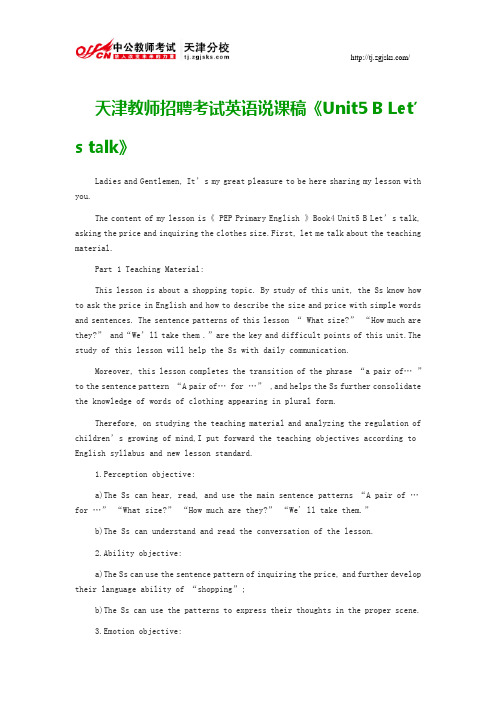
/天津教师招聘考试英语说课稿《Unit5 B Let’s talk》Ladies and Gentlemen, It’s my great pleasure to be here sharing my lesson with you.The content of my lesson is《 PEP Primary English 》Book4 Unit5 B Let’s talk, asking the price and inquiring the clothes size.First, let me talk about the teaching material.Part 1 Teaching Material:This lesson is about a shopping topic. By study of this unit, the Ss know how to ask the price in English and how to describe the size and price with simple words and sentences. The sentence patterns of this lesson “ What size?”“How much are they?” and“We’ll take them .”are the key and difficult points of this unit.The study of this lesson will help the Ss with daily communication.Moreover, this lesson completes the transition of the phrase “a pair of…”to the sentence pattern “A pair of… for …” ,and helps the Ss further consolidate the knowledge of words of clothing appearing in plural form.Therefore, on studying the teaching material and analyzing the regulation of children’s growing of mind,I put forward the teaching objectives according to English syllabus and new lesson standard.1.Perception objective:a)The Ss can hear, read, and use the main sentence patterns “A pair of …for …”“What size?”“How much are they?”“We' ll take them.”b)The Ss can understand and read the conversation of the lesson.2.Ability objective:a)The Ss can use the sentence pattern of inquiring the price, and further develop their language ability of “shopping”;b)The Ss can use the patterns to express their thoughts in the proper scene.3.Emotion objective:/a)By completing the task,the Ss increase their interest and set upself-confidence in language study;b)Teach the Ss what is “love” and “ managing money matters”, put the moral education in the language study.Next,the key points of this lesson:First of all, to study and use the sentence patterns “What size?”“How much are they ?”“A pair of … for … .”“We' ll take them.”To improve the Ss’ abilities in “shopping”;Secondly, teach the Ss how to study independently as well as by cooperation.Difficult points:The Ss can use the words and patterns to describe the clothes in the proper scene, and make simple dialogues of shopping.Well, how to achieve the teaching objectives better, to stress the key points and break through the difficult points? The key is how to make use of the proper teaching methods, I’ll talk about my teaching methods below.中公天津教师考试网/。
新编实用英语教案unit5
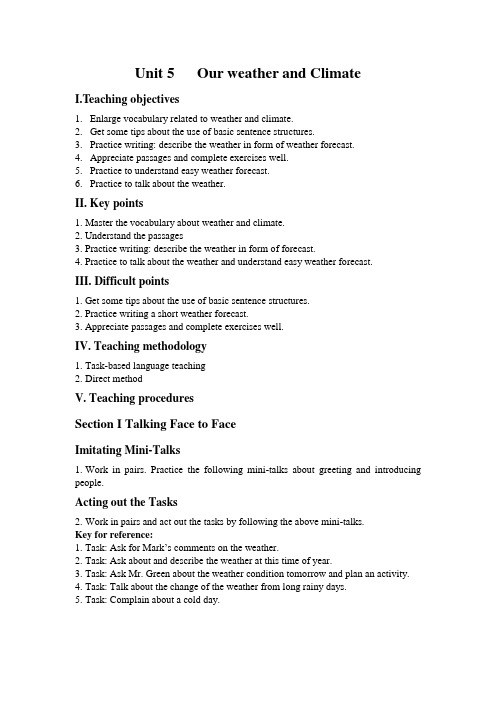
Unit 5 Our weather and ClimateI.Teaching objectives1.Enlarge vocabulary related to weather and climate.2.Get some tips about the use of basic sentence structures.3.Practice writing: describe the weather in form of weather forecast.4.Appreciate passages and complete exercises well.5.Practice to understand easy weather forecast.6.Practice to talk about the weather.II. Key points1.Master the vocabulary about weather and climate.2. Understand the passages3. Practice writing: describe the weather in form of forecast.4. Practice to talk about the weather and understand easy weather forecast.III. Difficult points1. Get some tips about the use of basic sentence structures.2. Practice writing a short weather forecast.3. Appreciate passages and complete exercises well.IV. Teaching methodology1.Task-based language teaching2.Direct methodV. Teaching proceduresSection I Talking Face to FaceImitating Mini-Talks1.Work in pairs. Practice the following mini-talks about greeting and introducing people.Acting out the Tasks2.Work in pairs and act out the tasks by following the above mini-talks.Key for reference:1.Task: Ask for Mark’s comments on the weather.2.Task: Ask about and describe the weather at this time of year.3.Task: Ask Mr. Green about the weather condition tomorrow and plan an activity.4.Task: Talk about the change of the weather from long rainy days.5.Task: Complain about a cold day.Studying Weather Forecasts3.A weather forecast id a statement that tells the public what the weather condition is going to be. We need to watch weather forecasts on TV or hear them over the radio every day.It is part of our life.Read the following samples of weather forecasts carefully and try to use the information to practice short dialogues.Following Sample Dialogues4.Read the following sample dialogues and try to perform your own tasks.Putting Language to Use5.Mr. Parks is talking about the weather of two places in the United States with her students.Read aloud the following dialogue with your partner by putting in the missing words.6.There is going to be s sports meet tomorrow.Bob is worried about the weather and you are talking about it. Fill in the blanks according to the clues given in the brackets. Then act it out with your partner.1.Listen to 10 sentences for workplace communication cross-referenced with their Chinese translations.Script: (e.g) 1. It look likes rain.2. Is it going to be fine this weekend?3. There is a chance of snow this evening.4. Today will be cool and partly cloudy, with a chance of rain this afternoon.5. What’s the temperature today?2.Listen to the following sentences for workplace communication in Column A and match each one with its Chinese version in Column B.3.Listen to 6 sentences for workplace communication and choose their right responses.Handling a Dialogue4.Listen to a dialogue and decode the message by finding out the correct choices in the brackets according to what you have heard.Understanding a Short Speech/Talk5.Now listen to a short speech/talk and fill up the blanks according to what you have heard.The words in brackets will give you some hints.6.Listen to the speech/talk again and complete the information in Column A with the right choices in Column B.Section III Trying Your HandPracticing Applied Writing1.Read the following two samples of weather report and learn to write your own.2.Translate the following weather forecast into Chinese, using the data bank in the Workbook for reference.3.Write an English weather report according to the information given in Chinese. Writing Sentences and Reviewing Grammar4.Analyze the following sentences to see what tense they belong to .5.Correct the errors in the following sentences.6.Translate the following sentences into English.Keys for the exercise:1)The weather was terrible yesterday. In fact, it has been awful.2)She has worked in this office for five years.3)I paid a visit to the Great Wall last year and had a very good time there.4)We have never spoken to each other since we quarreled last time.5)Turn down the TV a bit, the weather forecast hasn’t begun yet.Write and Describe a PictureWrite a short passage of about 100 words to tell a story or about an event related to the picture given below. Some useful words and phrases have been provided to help you.Section IV Maintaining a Sharp EyePassage onermation Related to the Reading Passagenguage Points:3.Explanation of Difficult Sentences1)(para.1) Climate change may be a big problem,but there are many little things we can do to make a difference.Analysis: May can be used to introduce concession in putting forward an argument. 2)(para.1) As we have learned, these greenhouse gases trap energy in the atmosphere and make the Earth warmer.Analysis:As is often used to introduce an indicator of the information source, such as as we have learned. Similar structure are:as the saying goes,as everyone knows, as you know,as you put it,etc.3)(para.3)By turning off lights, the television,and the computer when you are through with them, you can help a lot.Analysis: By is followed by a gerund, introducing a prepositional phrase of manner.Note,by is not necessarily always translated as “通过”.4)(para.8)One of the ways to reduce the amount of greenhouse gases that we put into the air is to buy pro ducts that don’t use as much energy.Analysis:Two That-clauses are used to serve as post-modifiers of nouns:the first one is that we put into the air, modifying greenhouse gases;The second that-clause is that don’t use as much energy, modifying products. Note: In translation, the noun phrase products that use as much energ y can simply be translated into”节能产品”, instead of “不消耗那么多能量的产品”.B. Important Words1)trap:v store(energy, gas or water,etc.)so that it cannot escape.2)Stand-by:n. Readiness for duty.3)Absorb:v. Take in,sack up (liquid,heat,knowledge,etc.)4)Membership: n. Being a member of (an organization)5)Swell:v. (number or amounts) grow bigger; expand.4. Passage Translation5. Read and Think: Answer the following questions according to the passage.6. Read and Complete1)Complete each of the following statements with words or phrases from thepassage.2)Fill in the blanks with the proper words or expressions given below, changing theform if necessary.7. Read and Translate8. Read and SimulatePassage twoInformation Related to the Reading Passagenguage Points:A.Explanation of Difficult Sentences1)(para.1) The most important thing to remember about the weather in Britain is that it often changes.Analysis: To remember about ...is the post modifier of the sentence subject the most important thing, and that introduces the complement clause.2)(para.1)As it is not very common in Britain to have long periods when the weather stays the same day after day, the kind of weather you get will depend not only on the time of year, but also on the luck.Analysis: Within the as-clause of reason, there is a relative clause introduced by when and modifying periods. And in its main clause, there is another relative clause you get modifying weather, with the relative that omitted.3)(para.2) For example, the opportunities for people to meet outside depend a lot on the weather, so you won’t see people meeting or spending time together outdoors asmuch as you do in hotter countries.Analysis:for people to meet outside modifies opportunities.Both meeting or spending time together are the object complement of verb see, and do refers to see...4)(para.3) Foreigners are often amused that the British people spend so much time discussing the weather.Analysis:That is often used to introduce a clause which gives the cause or the effect of an adjective, just like amused in this case.5)(para.4) Another reason is that the British people are reluctant to converse about personal matters with people who are not friends.Analysis:Here that introduces a subject-complement clause, in which a relative who-clause modified people.6)(Para.4) A comment on a nice day or a personal complaint about the rain is an easy way to break the ice.Analysis:Note that when or is used to coordinate two subjects, the verb must agree with the subject after or. To break the ice is an infinitive clause modifying an easy way.B. Important Words1)depend: v. A.change according to(no passive)B. Need someone or something for help or to be able to live.2)opportunity:n. A favorable moment or occasion (for doing sth.)3)Outdoors:ad. In the open air4)Amuse:v. Make someone laugh;cause laughter in5)Climate: n. The average conditions at a particular place over a period of year.6)Discuss:v. Talk about7)Variable:a. Changeable, not steady8)Reluctant:a. Unwilling and therefore perhaps slow to act.9)Converse:v. Talk informally10)Personally:a. Belonging or relating to a particular person, not to others11)Social:a.relating to leisure activities that involve meeting other people12)Comment:v. Make a remark, give an opinion2.Passage Translation3.Read and Judge: True/False4.Read and Translate: Translate the following sentences into Chinese.1)the most important thing to remember about British is the weather.2)People in Britain can enjoy the lovely weather most of the year.3)British people tend to talk about weather quite a lot.4)It is quite common in Britain for people to comment on a rainy day or an lovely day at a bus stop.5)The eating habits of people in Britain have a lot to do with the weather conditions there.6)The best we may use to describe the weather in Britain is “predictable”.7)The variable weather explains why British people talk a lot about it.8)Talking about weather is an inoffensive way to begin a conversation with a stranger in Britain.Section V Appreciating Culture Tips (Open.)。
大学英语老师的面试说课英语简单自我介绍
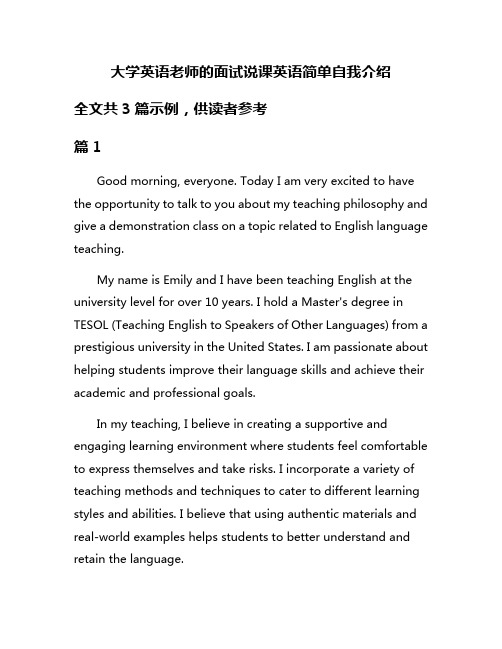
大学英语老师的面试说课英语简单自我介绍全文共3篇示例,供读者参考篇1Good morning, everyone. Today I am very excited to have the opportunity to talk to you about my teaching philosophy and give a demonstration class on a topic related to English language teaching.My name is Emily and I have been teaching English at the university level for over 10 years. I hold a Master's degree in TESOL (Teaching English to Speakers of Other Languages) from a prestigious university in the United States. I am passionate about helping students improve their language skills and achieve their academic and professional goals.In my teaching, I believe in creating a supportive and engaging learning environment where students feel comfortable to express themselves and take risks. I incorporate a variety of teaching methods and techniques to cater to different learning styles and abilities. I believe that using authentic materials and real-world examples helps students to better understand and retain the language.For today's demonstration class, I have chosen the topic of "Describing People" for intermediate-level students. This topic is not only useful for everyday communication but also helps students expand their vocabulary and practice using adjectives and descriptive language.I will start the class by reviewing vocabulary related to physical appearance and personality traits. I will then engage the students in a communicative activity where they have to describe a partner to a group of their peers. This activity will not only help students practice the target language but also improve their speaking and listening skills.After the activity, I will introduce a reading passage about a famous person and discuss the vocabulary and grammar structures used in the text. This will provide students with authentic language input and help them see how the target language is used in context.To wrap up the class, I will assign a writing task where students have to describe a family member or friend using the vocabulary and structures learned in class. This will give students the opportunity to practice their writing skills and apply what they have learned.In conclusion, I strive to create a dynamic and interactive learning environment where students can thrive and reach their full potential. I am looking forward to sharing my passion for teaching with you all today. Thank you for your attention.篇2Good morning everyone, my name is Sarah and I am here today to introduce myself and talk about a lesson I would give as a university English teacher during a job interview.I have a Bachelor’s degree in English literature and a Master’s degree in Applied Linguistics. I have been teaching English as a second language for over 10 years, both in classrooms and online. I am passionate about language learning and communication and I strive to create engaging and interactive lessons for my students.If I were to demonstrate a lesson on a job interview, I would start by introducing the topic and explaining the purpose of the lesson. I would then present some key vocabulary related to job interviews, such as “resume”, “cover letter”, “skills”, and “experience”. I would use real-life examples and encourage students to practice using the vocabulary in context.Next, I would focus on common interview questions and how to answer them effectively. I would give examples of both good and bad responses, and encourage students to think critically about how they would respond in a real interview situation.Finally, I would have students participate in a mock interview exercise, where they would take turns playing the roles of interviewer and interviewee. This would give them the opportunity to practice their speaking and listening skills, as well as receive feedback from their peers.Overall, my goal as a teacher is to create a supportive and dynamic learning environment where students feel confident to practice and improve their English skills. Thank you for listening to my presentation, and I look forward to answering any questions you may have.篇3Good morning everyone, my name is Sarah and I am excited to be here today to present my teaching demonstration for the position of college English teacher. I have a strong passion for teaching and a deep understanding of the English language, andI believe that I can make a positive impact on the students in this institution.Before we begin, let me give you a brief overview of my educational background and teaching experience. I have a Bachelor's degree in English Literature from the University of Cambridge and a Master's degree in TESOL (Teaching English to Speakers of Other Languages) from Oxford University. I have been teaching English for over 10 years, both in traditional classrooms and online settings. I have taught students of all levels and ages, from young learners to adult professionals.Today, I will be presenting a lesson on writing a persuasive essay. I have chosen this topic because I believe that it is important for students to be able to effectively communicate their ideas and persuade others to see their point of view. I will begin by giving a brief introduction to the topic, discussing the purpose of a persuasive essay and the elements that make up a strong argument. I will then walk the students through the process of brainstorming ideas, organizing their thoughts, and writing a clear and cohesive essay.Throughout the lesson, I will use a variety of teaching techniques to engage the students and make the material accessible to all learners. I will incorporate visual aids, groupdiscussions, and interactive activities to create a dynamic and stimulating learning environment. I will also provide individualized feedback and support to help each student reach their full potential.In conclusion, I believe that my educational background, teaching experience, and passion for English language teaching make me a strong candidate for the position of college English teacher. I am dedicated to helping students achieve their language learning goals and I am committed to creating a positive and supportive learning environment. Thank you for considering me for this position.。
大学英文试讲教案模板及范文
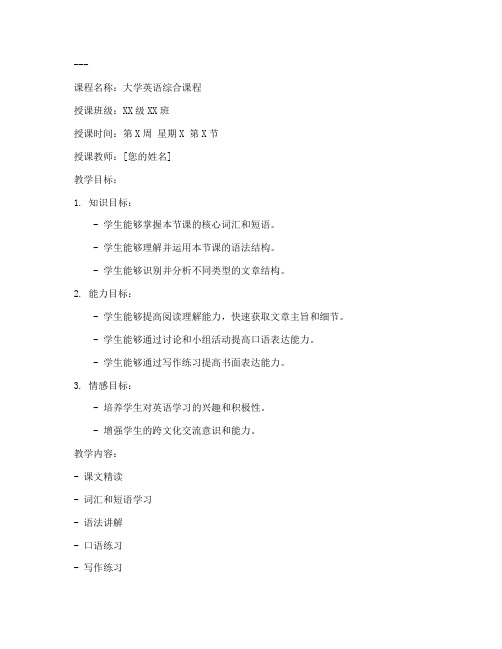
---课程名称:大学英语综合课程授课班级:XX级XX班授课时间:第X周星期X 第X节授课教师:[您的姓名]教学目标:1. 知识目标:- 学生能够掌握本节课的核心词汇和短语。
- 学生能够理解并运用本节课的语法结构。
- 学生能够识别并分析不同类型的文章结构。
2. 能力目标:- 学生能够提高阅读理解能力,快速获取文章主旨和细节。
- 学生能够通过讨论和小组活动提高口语表达能力。
- 学生能够通过写作练习提高书面表达能力。
3. 情感目标:- 培养学生对英语学习的兴趣和积极性。
- 增强学生的跨文化交流意识和能力。
教学内容:- 课文精读- 词汇和短语学习- 语法讲解- 口语练习- 写作练习教学过程:一、导入(5分钟)1. 引入话题:简要介绍本节课的主题,激发学生兴趣。
2. 播放与本节课主题相关的短视频或音乐,引导学生进入学习状态。
二、课文精读(20分钟)1. 阅读课文,整体感知文章内容。
2. 针对文章结构,分析段落大意和主题句。
3. 针对生词和短语,进行讲解和造句练习。
三、词汇和短语学习(10分钟)1. 列出本节课的生词和短语,并进行解释。
2. 学生进行词汇和短语翻译练习。
3. 设计游戏或活动,帮助学生记忆词汇和短语。
四、语法讲解(10分钟)1. 针对本节课的语法点,进行讲解和示例。
2. 学生进行语法练习,巩固所学知识。
五、口语练习(10分钟)1. 设计话题,让学生进行小组讨论。
2. 邀请学生上台进行角色扮演或自由发言。
六、写作练习(10分钟)1. 题目:[根据本节课主题设计题目]2. 学生进行写作练习,教师巡视指导。
七、课堂小结(5分钟)1. 总结本节课所学内容,强调重点和难点。
2. 布置课后作业,巩固所学知识。
八、课后作业1. 阅读课文,完成课后练习。
2. 复习本节课所学词汇和短语。
3. 完成写作练习。
---范文示例课程名称:大学英语综合课程授课班级:XX级XX班授课时间:第3周星期三第3节授课教师:张华教学目标:1. 知识目标:- 学生能够掌握本节课的核心词汇如“globalization”、“technology”等。
英语讲天气的讲课稿模板
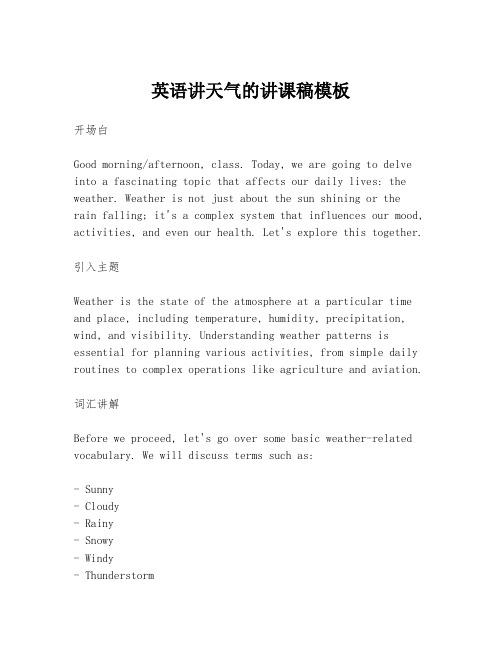
英语讲天气的讲课稿模板开场白Good morning/afternoon, class. Today, we are going to delve into a fascinating topic that affects our daily lives: the weather. Weather is not just about the sun shining or therain falling; it's a complex system that influences our mood, activities, and even our health. Let's explore this together.引入主题Weather is the state of the atmosphere at a particular time and place, including temperature, humidity, precipitation, wind, and visibility. Understanding weather patterns is essential for planning various activities, from simple daily routines to complex operations like agriculture and aviation.词汇讲解Before we proceed, let's go over some basic weather-related vocabulary. We will discuss terms such as:- Sunny- Cloudy- Rainy- Snowy- Windy- Thunderstorm- Humidity- Temperature天气现象解释Now, let's talk about different weather phenomena and how they occur.- Sunny: When the sun is shining brightly and there are no clouds blocking its rays.- Cloudy: When the sky is covered with clouds, reducing the amount of sunlight that reaches the ground.- Rainy: When there is precipitation in the form of liquid water droplets.- Snowy: When precipitation occurs as ice crystals, usually when the temperature is below freezing.- Windy: When there is a significant movement of air in the atmosphere.- Thunderstorm: A storm characterized by the presence of lightning and its acoustic effect of thunder.温度与湿度Temperature and humidity are two critical factors in weather. Temperature measures how hot or cold the air is, usually in degrees Celsius or Fahrenheit. Humidity refers to the amount of water vapor in the air and is often expressed as a percentage.天气预报Forecasting the weather is an essential part of meteorology. Meteorologists use various tools and data to predict weather conditions. Let's discuss how weather forecasts are made and the common phrases used in weather reports.- Highs and lows: Referring to the expected maximum and minimum temperatures.- Chance of precipitation: The likelihood of rain or other forms of precipitation.- Wind speed and direction: How fast the wind is blowing and from which direction.实践活动To better understand weather, let's engage in a practical activity. I will provide you with a weather report from acity of your choice. Your task is to interpret the report and describe what the weather will be like in simple English.课堂互动Now, let's have a brief discussion. Share with your classmates the weather in your hometown or a place you've visited. What was the weather like? How did it affect your activities?结束语As we conclude today's lesson, remember that weather is a dynamic part of our environment. By understanding it, we can better prepare for the day ahead and make informed decisions.Keep observing and learning about the weather, and you'llfind it an integral part of your life.作业布置For your homework, I'd like you to monitor the weather for a week and keep a journal of the daily weather conditions, including temperature, precipitation, and any notable weather events. Next class, we'll share our observations and discuss any patterns or interesting findings.This template provides a comprehensive approach to teaching about weather in English, covering vocabulary, concepts, practical application, and homework for reinforcing the lesson.。
高校英语试讲说课稿模板

高校英语试讲说课稿模板尊敬的评委老师,各位同学,大家好。
今天,我将为大家试讲一节英语课,课程的主题是“跨文化交流”,这是我们英语教学中一个非常重要的话题。
接下来,我将从教学目标、教学内容、教学方法、教学过程、教学评价这五个方面来展开我的说课。
一、教学目标1. 知识目标:学生能够了解跨文化交流的基本概念,掌握基本的跨文化交际技巧。
2. 技能目标:通过情景模拟和角色扮演,提高学生的跨文化沟通能力。
3. 情感目标:培养学生对不同文化的尊重和理解,增强跨文化交流的意识。
二、教学内容本节课的教学内容主要包括:- 跨文化交流的定义和重要性。
- 跨文化交际中常见的障碍和解决方法。
- 跨文化交际技巧的介绍,如非语言交流、倾听技巧等。
三、教学方法1. 讲授法:通过讲解,向学生传授跨文化交流的理论知识。
2. 讨论法:组织学生就跨文化交流的案例进行讨论,激发学生的思考。
3. 角色扮演:通过模拟不同文化背景下的交流情景,让学生实践跨文化沟通技巧。
4. 案例分析:分析跨文化交流的成功与失败案例,让学生从中学习经验。
四、教学过程1. 导入(5分钟):通过提问和讨论,激发学生对跨文化交流的兴趣。
2. 新课呈现(15分钟):系统讲解跨文化交流的理论知识。
3. 情景模拟(15分钟):分组进行角色扮演,模拟跨文化沟通场景。
4. 案例分析(10分钟):分析跨文化交流的案例,让学生总结经验教训。
5. 小结与作业布置(5分钟):总结本节课的重点内容,布置相关的课后作业。
五、教学评价1. 课堂参与度:评价学生在课堂上的参与情况和讨论的积极性。
2. 角色扮演表现:评价学生在角色扮演环节的表现,包括语言运用和非语言交流。
3. 课后作业:通过作业完成情况,评价学生对本节课内容的掌握程度。
最后,我相信通过本节课的学习,学生们不仅能够掌握跨文化交流的相关知识和技能,还能够培养出开放和包容的心态,为将来在全球化背景下的工作和生活打下坚实的基础。
谢谢大家。
2016年云南教师招聘面试(试讲)技巧:《Unit5 what’s the weather like today》
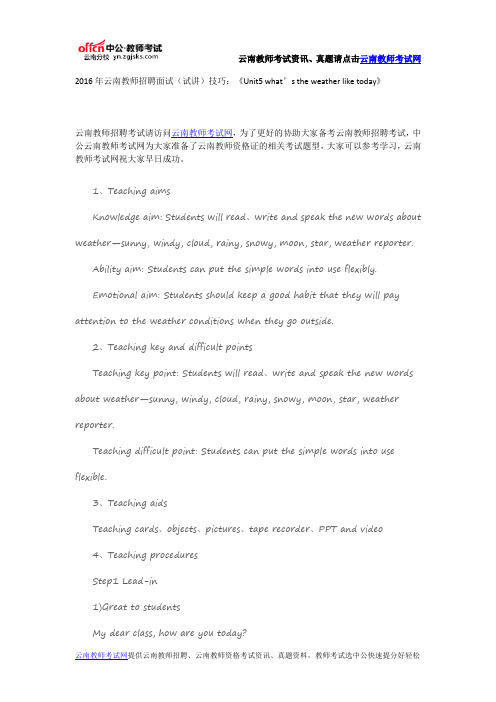
2016年云南教师招聘面试(试讲)技巧:《Unit5 what’s the weather like today》云南教师招聘考试请访问云南教师考试网,为了更好的协助大家备考云南教师招聘考试,中公云南教师考试网为大家准备了云南教师资格证的相关考试题型,大家可以参考学习,云南教师考试网祝大家早日成功。
1、Teaching aimsKnowledge aim: Students will read、write and speak the new words about weather—sunny, windy, cloud, rainy, snowy, moon, star, weather reporter.Ability aim: Students can put the simple words into use flexibly.Emotional aim: Students should keep a good habit that they will pay attention to the weather conditions when they go outside.2、Teaching key and difficult pointsTeaching key point: Students will read、write and speak the new words about weather—sunny, windy, cloud, rainy, snowy, moon, star, weather reporter.Teaching difficult point: Students can put the simple words into use flexible.3、Teaching aidsTeaching cards、objects、pictures、tape recorder、PPT and video4、Teaching proceduresStep1 Lead-in1)Great to studentsMy dear class, how are you today?2) Sing a songRain, rain, go away.Come again another day.Little John wants to play.Rain, rain, go away.3)ReviewDo you still remember what we have learned last class? Who can try?4)Free talkWhat do you want to know if you are going to have a travel?Step2 Presentation (Part A let’s learn)1)New words-sunny, windy, cloud, rainy, snowy, moon, stara、The teacher use the picture to help students learn the new words snowy, windy, cloudy, rainy and sunny by show word card.b、The teacher add the magic letter“y”, to review the word snowy, windy, cloudy, rainy and sunny .c、The teacher present the PPT, and guide students to learn the words star and moon.2)Phrase-weather reportThe teacher plays the video about the weather forecast prepared, and guid students to learn phrase-weather report.3)Activitya、The teacher play the tape recorder, and the students should imitate the tone of the new word in Part A let’s learn.b、The teacher should show the word cards, and students should read it as quickly as possible.Step3 Consolidation1)Let’s doI say you do. When I say rainy, you should do action “cold”. Got it?2)Let’s chantWhat’s weather like today?It’s hualalala rainy day.What’s weather like today?It’s huhuhuhu windy day.What’s weather like today?It’s honglonglonglong cloudy day.What’s weather like today?It’s shuashuashuashua sunny day.Step4 Summary and homework1)Summary: Let’s read the new words on the blackboard.2)Homework: search the weather conditions of Beijing、Guangzhou、Chengdu、Shanghai and Lanzhou in a week, and share it with us next class.5、Blackboard design6、Teaching reflection中公资深讲师方芳解析更多云南教师资格证考试、云南教师招聘考试信息尽在云南教师考试网,欢迎广考生访问。
Unit5weather教案
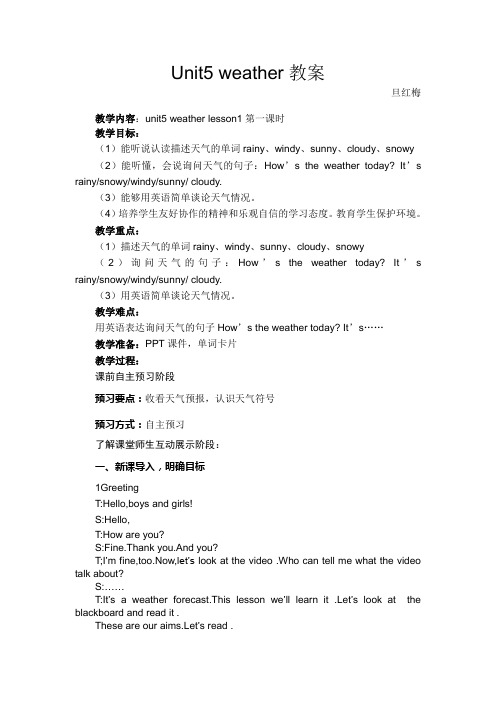
Unit5 weather教案旦红梅教学内容:unit5 weather lesson1第一课时教学目标:(1)能听说认读描述天气的单词rainy、windy、sunny、cloudy、snowy (2)能听懂,会说询问天气的句子:How’s the weather today? It’s rainy/snowy/windy/sunny/ cloudy.(3)能够用英语简单谈论天气情况。
(4)培养学生友好协作的精神和乐观自信的学习态度。
教育学生保护环境。
教学重点:(1)描述天气的单词rainy、windy、sunny、cloudy、snowy(2)询问天气的句子:How’s the weather today? It’s rainy/snowy/windy/sunny/ cloudy.(3)用英语简单谈论天气情况。
教学难点:用英语表达询问天气的句子How’s the weather today? It’s……教学准备:PPT课件,单词卡片教学过程:课前自主预习阶段预习要点:收看天气预报,认识天气符号预习方式:自主预习了解课堂师生互动展示阶段:一、新课导入,明确目标1GreetingT:Hello,boys and girls!S:Hello,T:How are you?S:Fine.Thank you.And you?T;I’m fine,too.Now,let’s look at the video .Who can tell me what the video talk about?S:……T:It’s a weather forecast.This lesson we’ll learn it .Let’s look at the blackboard and read it .These are our aims.Let’s read .二、学习交流,合作探究1 These words can describe the weather.Let’s learn the new words.Weather,sunny,cloudy,rainy,snowy,windy采用分组、个别、男女生等形式进行操练。
新编实用英语教案unit5

新编实用英语教案unit5第一篇:新编实用英语教案unit5Unit 5Our weather and Climate I.Teaching objectives1.2.3.4.5.6.Enlarge vocabulary related to weather and climate.Get some tips about the use of basic sentence structures.Practice writing: describe the weather in form of weather forecast.Appreciate passages and complete exercises well.Practice to understand easy weather forecast.Practice to talk about the weather.II.Key points 1.Master the vocabulary about weather and climate.2.Understand the passages 3.Practice writing: describe the weather in form of forecast.4.Practice to talk about the weather and understand easy weather forecast.III.Difficult points 1.Get some tips about the use of basic sentence structures.2.Practice writing a short weather forecast.3.Appreciate passages and complete exercises well.IV.Teaching methodology1.Task-based language teaching2.Direct method V.Teaching procedures Section I Talking Face to Face Imitating Mini-Talks 1.Work in pairs.Practice the following mini-talks about greeting and introducing people.Acting out the Tasks 2.Work in pairs and act out the tasks by following the above mini-talks.Key for reference: 1.Task: Ask for Mark’s comments on the weather.2.Task: Ask about and describe the weather at this time of year.3.Task: Ask Mr.Green about the weather condition tomorrow and plan an activity.4.Task: Talk about the change of the weather from long rainy days.5.T ask: Complain about a cold day.Studying Weather Forecasts 3.A weather forecast id a statement that tells the public what the weather condition isgoing to be.We need to watch weather forecasts on TV or hear them over the radio every day.It is part of our life.Read the following samples of weather forecasts carefully and try to use the information to practice short dialogues.Following Sample Dialogues4.Read the following sample dialogues and try to perform your own tasks.Putting Language to Use5.Mr.Parks is talking about the weather of two places in the United States with her students.Read aloud the following dialogue with your partner by putting in the missing words.6.There is going to be s sports meet tomorrow.Bob is worried about the weather and you are talking about it.Fill in the blanks according to the clues given in the brackets.Then act it out with your partner.1.Listen to 10 sentences for workplace communication cross-referenced with their Chinese translations.Script:(e.g)1.It look likes rain.2.Is it going to be fine this weekend?3.There is a chance of snow this evening.4.Today will be cool and partly cloudy, with a chance of rain this afternoon.5.What’s the temperature today?2.Listen to the following sentences for workplace communication in Column A and match each one with its Chinese version in Column B.3.Listen to 6 sentences for workplace communication and choose their right responses.Handling a Dialogue4.Listen to a dialogue and decode the message by finding out the correct choices in the brackets according to what you have heard.Understanding a Short Speech/Talk5.Now listen to a short speech/talk and fill up the blanks according to what you have heard.The words in brackets will give you some hints.6.Listen to the speech/talk again and complete the information in Column A with the right choices in ColumnB.Section III Trying Your Hand Practicing Applied Writing 1.Read the following two samples of weather report and learn to write your own.2.Translate the following weather forecast into Chinese, using the data bank in the Workbook for reference.3.Write an English weather report according to the information given in Chinese.Writing Sentences and Reviewing Grammar 4.Analyze the following sentences to see what tense they belong to.5.Correct the errors in the following sentences.6.Translate the following sentences into English.Keys for the exercise: 1)The weather was terrible yesterday.In fact, it has been awful.2)She has worked in this office for five years.3)I paid a visit to the Great Wall last year and had a very good time there.4)We have never spoken to each other since we quarreled last time.5)Turn down the TV a bit, the weather forecast hasn’t begun yet.Write and Describe a Picture Write a short passage of about 100 words to tell a story or about an event related to the picture given below.Some useful words and phrases have been provided to help you.Section IV Maintaining a Sharp Eye Passage onermation Related to the Reading Passagenguage Points:3.Explanation of Difficult Sentences 1)(para.1)Climate change may be a big problem,but there are many little things we can do to make a difference.Analysis: May can be used to introduce concession in putting forward an argument.2)(para.1)As we have learned, these greenhouse gases trap energy in the atmosphere and make the Earth warmer.Analysis:As is often used to introduce an indicator of the information source, such as as we have learned.Similar structure are:as the saying goes,as everyone knows, as you know,as you put it,etc.3)(para.3)By turning off lights, the television,and the computerwhen you are through with them, you can help a lot.Analysis: By is followed by a gerund, introducing a prepositional phrase of manner.Note,by is not necessarily always translated as “通过”.4)(para.8)One of the ways to reduce the amount of greenhouse gases that we put into the air is to buy products that don’t use as much energy.Analysis:Two That-clauses are used to serve as post-modifiers of nouns:the first one is that we put into the air, modifying greenhouse gases;The second that-clause is that don’t use as much energy, modifying products.Note: In translation, the noun phrase products that use as much energy can simply be translated into”节能产品”, instead of “不消耗那么多能量的产品”.B.Important Words 1)trap:v store(energy, gas or water,etc.)so that it cannot escape.2)Stand-by:n.Readiness for duty.3)Absorb:v.Take in,sack up(liquid,heat,knowledge,etc.)4)Membership: n.Being a member of(an organization)5)Swell:v.(number or amounts)grow bigger;expand.4.Passage Translation 5.Read and Think: Answer the following questions according to the passage.6.Read and Complete1)Complete each of the following statements with words or phrases from the passage.2)Fill in the blanks with the proper words or expressions given below, changing theform if necessary.7.Read and Translate 8.Read and Simulate Passage two Information Related to the Reading Passage nguage Points: A.Explanation of Difficult Sentences 1)(para.1)The most important thing to remember about the weather in Britain is that it often changes.Analysis: To remember about...is the post modifier of the sentence subject the most important thing, and that introduces the complement clause.2)(para.1)As it is not very common in Britain to have longperiods when the weather stays the same day after day, the kind of weather you get will depend not only on the time of year, but also on the luck.Analysis: Within the as-clause of reason, there is a relative clause introduced by when and modifying periods.And in its main clause, there is another relative clause you get modifying weather, with the relative that omitted.3)(para.2)For example, the opportunities for people to meet outside depend a lot on the weather, so you won’t see people meeting or spending time together outdoors as much as you do in hotter countries.Analysis: for people to meet outside modifies opportunities.Both meeting or spending time together are the object complement of verb see, and do refers to see...4)(para.3)Foreigners are often amused that the British people spend so much time discussing the weather.Analysis: That is often used to introduce a clause which gives the cause or the effect of an adjective, just like amused in this case.5)(para.4)Another reason is that the British people are reluctant to converse about personal matters with people who are not friends.Analysis:Here that introduces a subject-complement clause, in which a relative who-clause modified people.6)(Para.4)A comment on a nice day or a personal complaint about the rain is an easy way to break the ice.Analysis:Note that when or is used to coordinate two subjects, the verb must agree with the subject after or.To break the ice is an infinitive clause modifying an easy way.B.Important Words1)depend: v.A.change according to(no passive)B.Need someone or something for help or to be able to live.2)opportunity:n.A favorable moment or occasion(for doing sth.)3)Outdoors:ad.In the open air 4)Amuse:v.Make someone laugh;cause laughter in 5)Climate: n.The average conditions at aparticular place over a period of year.6)Discuss:v.Talk about 7)Variable:a.Changeable, not steady 8)Reluctant:a.Unwilling and therefore perhaps slow to act.9)Converse:v.Talk informally 10)Personally:a.Belonging or relating to a particular person, not to others 11)Social:a.relating to leisure activities that involve meeting other people 12)Comment:v.Make a remark, give an opinion 2.Passage Translation 3.Read and Judge: True/False 4.Read and Translate: Translate the following sentences into Chinese.1)the most important thing to remember about British is the weather.2)People in Britain can enjoy the lovely weather most of the year.3)British people tend to talk about weather quite a lot.4)It is quite common in Britain for people to comment on a rainy day or an lovely day at a bus stop.5)The eating habits of people in Britain have a lot to do with the weather conditions there.6)The best we may use to describe the weather in Britain is “predictable”.7)The variable weather explains why British people talk a lot about it.8)Talking about weather is an inoffensive way to begin a conversation with a stranger in Britain.Section V Appreciating Culture Tips(Open.)第二篇:新编实用英语教案案首新编实用英语教案案首课程名称:新编实用英语Unit 1一、基本信息单元标题:unit1 Invitations 项目训练名称:Speaking And Writing 教学目标与要求: 1.能力目标:After learning this, the students should learn to make an oral invitation and write an invitation card or a letter for personal invitation or official occasions..They also can give a reply to an oral invitation and awritten invitation 知识目标:The words, the phrases and sentences about the invitations.二、学习重点与难点:1.The new words and phrases2.The sentences about the invitations3.The invitation cards or letters三、课时安排:2课时四、教法设计:讲授法、谈话法、讨论法、读书指导法、练习法五、教学用具:新编实用英语教案内容一、教学方法及建议:本单元设计利用任务驱动、情景模式教学,课堂上以学生活动为主,以锻炼学生分析问题,尝试解决问题、总结问题,最后真正解决问题的能力为目标,教师适当的引导,达到培养职业能力为主的目的。
高校老师英语说课稿模板
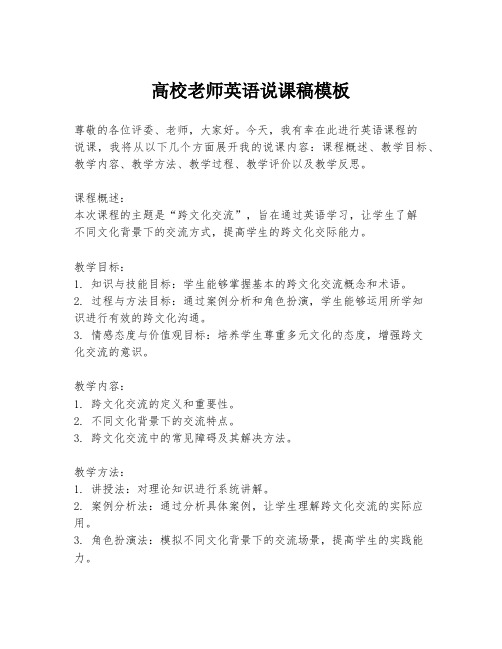
高校老师英语说课稿模板尊敬的各位评委、老师,大家好。
今天,我有幸在此进行英语课程的说课,我将从以下几个方面展开我的说课内容:课程概述、教学目标、教学内容、教学方法、教学过程、教学评价以及教学反思。
课程概述:本次课程的主题是“跨文化交流”,旨在通过英语学习,让学生了解不同文化背景下的交流方式,提高学生的跨文化交际能力。
教学目标:1. 知识与技能目标:学生能够掌握基本的跨文化交流概念和术语。
2. 过程与方法目标:通过案例分析和角色扮演,学生能够运用所学知识进行有效的跨文化沟通。
3. 情感态度与价值观目标:培养学生尊重多元文化的态度,增强跨文化交流的意识。
教学内容:1. 跨文化交流的定义和重要性。
2. 不同文化背景下的交流特点。
3. 跨文化交流中的常见障碍及其解决方法。
教学方法:1. 讲授法:对理论知识进行系统讲解。
2. 案例分析法:通过分析具体案例,让学生理解跨文化交流的实际应用。
3. 角色扮演法:模拟不同文化背景下的交流场景,提高学生的实践能力。
教学过程:1. 导入新课:通过一段跨文化交流的视频,激发学生兴趣。
2. 知识讲解:系统介绍跨文化交流的基本概念。
3. 案例分析:选取典型案例,引导学生分析并讨论。
4. 角色扮演:分组进行角色扮演,模拟跨文化交流场景。
5. 总结反馈:对学生的学习成果进行总结,并提出改进建议。
教学评价:1. 过程评价:观察学生在案例分析和角色扮演中的表现。
2. 结果评价:通过小测验或论文来评估学生对知识的掌握程度。
3. 自我评价:鼓励学生进行自我反思,评价自己的学习过程和结果。
教学反思:在教学结束后,我会反思本次课程的实施情况,包括教学方法的有效性、学生参与度以及教学目标的达成情况。
根据反思结果,调整教学策略,以期在下一次教学中取得更好的效果。
最后,我相信通过本次课程的学习,学生们不仅能够提升自己的英语水平,更能在跨文化交流中展现出更加自信和得体的沟通能力。
谢谢大家的聆听。
Unit 5 It will be sunny and cool tomorrow. (说课稿)-2
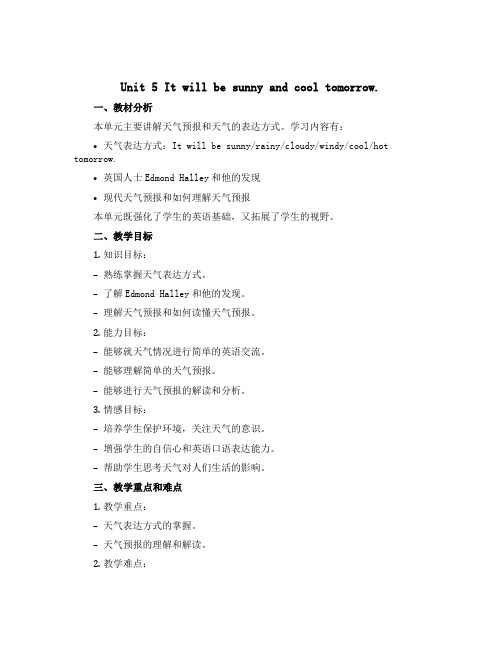
Unit 5 It will be sunny and cool tomorrow.一、教材分析本单元主要讲解天气预报和天气的表达方式。
学习内容有:•天气表达方式:It will be sunny/rainy/cloudy/windy/cool/hot tomorrow.•英国人士Edmond Halley和他的发现•现代天气预报和如何理解天气预报本单元既强化了学生的英语基础,又拓展了学生的视野。
二、教学目标1.知识目标:–熟练掌握天气表达方式。
–了解Edmond Halley和他的发现。
–理解天气预报和如何读懂天气预报。
2.能力目标:–能够就天气情况进行简单的英语交流。
–能够理解简单的天气预报。
–能够进行天气预报的解读和分析。
3.情感目标:–培养学生保护环境,关注天气的意识。
–增强学生的自信心和英语口语表达能力。
–帮助学生思考天气对人们生活的影响。
三、教学重点和难点1.教学重点:–天气表达方式的掌握。
–天气预报的理解和解读。
2.教学难点:–英语表达准确性的提高。
–天气预报的语言特点和解读方法的培养。
四、课程内容本单元教学分为三个部分,分别是听力、口语和阅读符号。
第一部分:听力1.展示天气预报视频,让学生先自己观看天气预报视频,并尝试听懂其中一些基本单词,比如“sunny”,“windy”,“cloudy”等。
2.教师播放天气预报视频,播放完毕后询问学生天气情况,并引导学生复述天气预报的内容。
第二部分:口语1.引导学生说出几种不同的天气状况,例如“It will be sunny tomorrow.”。
2.让学生互相询问天气情况,并尝试展开简单的英语交流,例如“How about your city?”。
3.分组让学生模拟天气预报员的角色,其中一位学生扮演天气预报员,向其他学生播报天气预报并进行问询交流。
第三部分:阅读符号1.介绍天气预报中的符号含义,如“-”表示温度下降,“+”表示温度上升等。
新编综合英语Unit 5 Our Weather and Climate
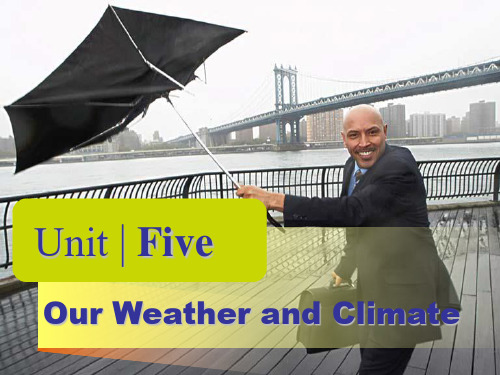
2 Task: Ask about and describe the weather at this time of year. 3 Task: Ask Mr. Green about the weather condition tomorrow and plan an activity. 4 Task: Talk about the change of the weather from long rainy days. 5 Task: Complain about a cold day.
教师招聘英语Unit5 ___ it说课稿
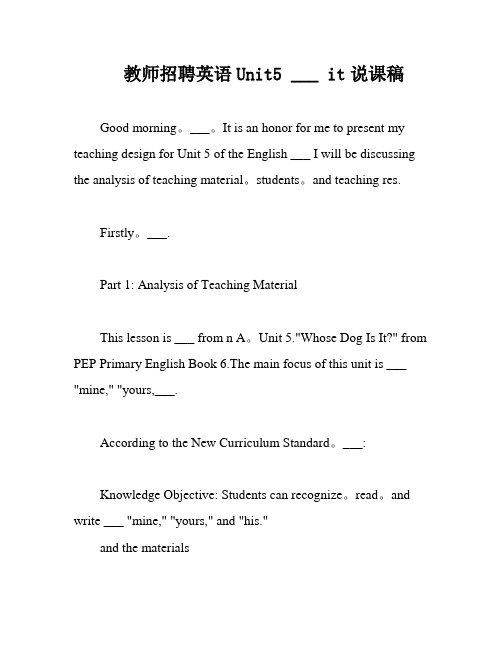
教师招聘英语Unit5 ___ it说课稿Good morning。
___。
It is an honor for me to present my teaching design for Unit 5 of the English ___ I will be discussing the analysis of teaching material。
students。
and teaching res.Firstly。
___.Part 1: Analysis of Teaching MaterialThis lesson is ___ from n A。
Unit 5."Whose Dog Is It?" from PEP Primary English Book 6.The main focus of this unit is ___ "mine," "yours,___.According to the New Curriculum Standard。
___:Knowledge Objective: Students can recognize。
read。
and write ___ "mine," "yours," and "his."and the materials___。
I will use games as the main ___ for students to learn and practice English。
For example。
I will use a game called "What's in the bag?" where students have to ask each other ns to guess what object is in a bag。
- 1、下载文档前请自行甄别文档内容的完整性,平台不提供额外的编辑、内容补充、找答案等附加服务。
- 2、"仅部分预览"的文档,不可在线预览部分如存在完整性等问题,可反馈申请退款(可完整预览的文档不适用该条件!)。
- 3、如文档侵犯您的权益,请联系客服反馈,我们会尽快为您处理(人工客服工作时间:9:00-18:30)。
2 Teaching Objectives
Knowledge Students master key expressions and
Aims
understand the main idea of the text.
Ability Aims
Students learn skimming and scanning to improve their independent reading ability.
a)Students skillfully use skimming and scanning to understand the main idea of the article and capture relevant information. b)Students use the vocabulary and sentence structures they have learned to talk about doing some meaningful little things to make a difference for helping make the planet a better place.
1 Teaching Material
1.2 Students
The topic of the article associated with the environment protection is close to students’ experience to arouse their interest in reading easily. The teacher should get the students to understand some difficult sentences to have a scientific understanding of climate change to do some meaningful little things to make a difference for helping make the planet a better place.
Strategy Students control their emotions and strategies in Aims reading to actively complete reading tasks
2 Teaching Objectives
Affect Aims
Students actively complete reading tasks independently and efficiently, and enhance their confidence in reading.
Lead in (2 min)
Whilereading
task (15min)
Classroom Test
Cultural Awareness
Students should open their minds and have a scientific understanding of climate change to do some meaningful little things to make a difference for helping make the planet a better place.
3 Key Points and Difficult Points
Key Points
Difficult Points
Байду номын сангаас
a)Students can learn the word expressions and understand the whole text. b)Students are able to use the simple past and present perfect to discuss with each other. c)Students can learn to read English texts independently, obtain relevant information and improve comprehensive reading ability.
1.1 Teaching content
The material is section IV taken from Unit5 in New Practical English Comprehensive Course (4th edition). The theme is We Can Make a Difference, which is a passage about what we people can do about climate change. The writer gives some excellent ways to help make the planet a better place. There are 10 paragraphs in this 397-word article in moderate length. Its outline is general part - sub-para part.
4 Teaching Methods
Methods
Teaching method
+ + + Question -and-answer teaching
Pair work or
individual
Free discussion
method
method
work
5 Teaching Procedure
Unit 5
Contents
1. Teaching Material
2. Objectives
3. Key Points and Difficult Points
4. Methods 5. Teaching Procedure 6. Blackboard-writing
1 Teaching Material
